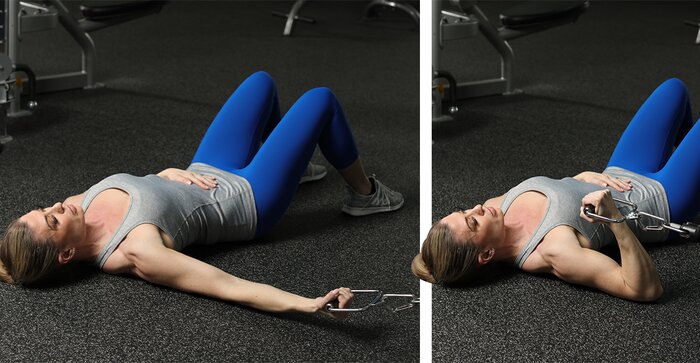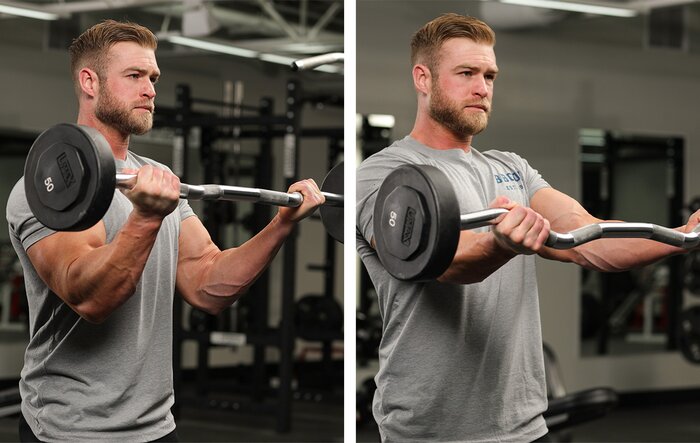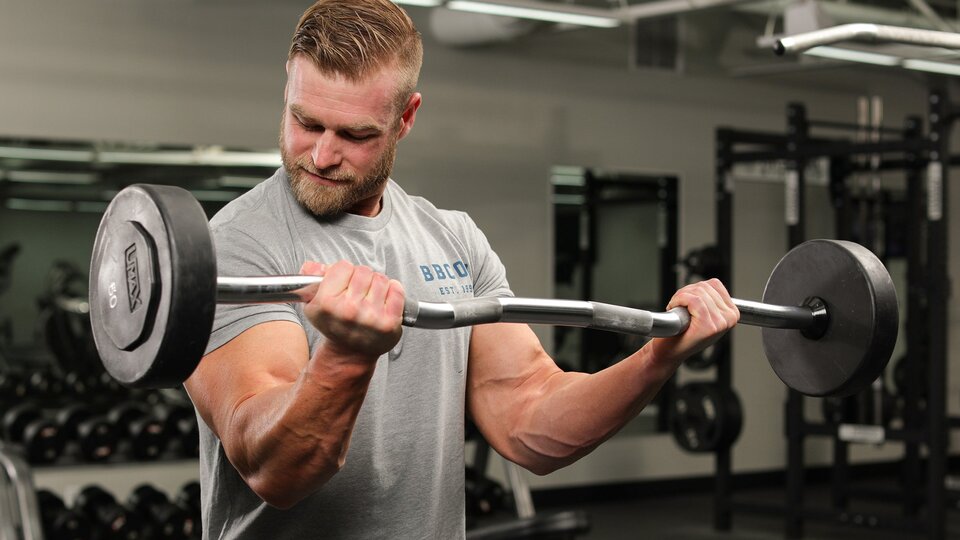Whether by boredom, restlessness, or simple curiosity, there’s just something fun and motivating when you come up with a new exercise to add to your training. Sure, more often than not you’ll discover that if it’s any good, someone else also “invented” it and has been using for years. Maybe decades. Who cares? That thrill of invention still can’t be beat.
Here are two biceps exercises that have become staples of mine over the 25 years or so that I’ve been in the fitness industry. I’ve used them and performed them all over the world, but if you feel I’m not the rightful inventor of the following exercises, then by all means let me know who is.
And if you have a unique exercise that you feel like you created, let Bodybuilding.com know in the comments or at [email protected]. But most importantly, try these two moves in your next arms workout and share them if they feel as great to you as they did to me.
Supine One-Arm Low-Cable Biceps Isolation Curl
- Latin Name: Biceps brachii sentinam Lockwood
- Inventor: Chris Lockwood, Ph.D., CSCS
- Invented: On 1-28-2018, while training in the Lockwood home gym, Draper, UT, USA
- Muscle Emphasis: Biceps brachii

Supine One-arm Low-cable Biceps Isolation Curl
The name is a mouthful but the setup is remarkably simple. All of your major biceps muscles—biceps brachii, brachioradialis, and brachialis—are active in the movement, but this exercise elicits a killer pump to your biceps brachii in particular. This is because your shoulder is in a 90-degree abducted position, which causes the long head of your biceps to begin the movement in a partially contracted state, whereas your short head begins in a partially stretched position.
A major benefit of this exercise, versus a basic standing curl a or single-arm high-cable curl, is that you’ll be able to more fully isolate your biceps by keeping your elbows and upper arm locked into place. With these variations there can be a tendency to use muscles of the chest and even the lats and teres muscles of the back to stabilize your body, especially when the weight gets heavy or you begin fatiguing.
Here’s how to do it:
- Attach a rotating D-handle to a low-cable pulley and select an appropriate amount of resistance. If you’ve never performed the movement, it might take a try or two to find the right weight.
- Lie face-up (supine) on the floor, with your body perpendicular to the pulley, about 3-4 feet away from the base of the cable attachment. Your shoulder should be even with the cable alignment of the pulley. Depending on your height, the handle attachment size, and the slack of the low-cable pulley, you may have to lie closer or farther away than 3-4 feet. If you’re in a cable-cross station, you can use your free hand to hold onto the other side of the station for extra stability.
- Extend your arm so that it’s 90 degrees from your side, outstretched toward the pulley handle. If someone were to stand over you, at your head, you should have the body position of an L or backward L, depending on the arm you’re about to train.
- Grab the handle with your wrist in a supinated (palms up) position. Do not let your shoulder rotate externally, up toward your head.
- While keeping your elbow and upper arm fixed against the floor, and without rotating your shoulder or wrist, contract your biceps so that your hand moves to a position above your armpit. Hold for a peak contraction, then slowly return to the start position and repeat for reps.
- Repeat with the other arm by rotating your body position by 180 degrees, so your other arm is extended toward the low-cable pulley.
Alternatives: Performing the curl with your wrist in a neutral (palm facing toward your feet) position will increase the involvement of your brachialis, similar to a hammer curl. Pronating your wrist (turning your palm to face away from you) will increase the involvement of your brachioradialis, similar to a reverse curl. But given the angle and line of resistance, you might have to step down in weight to make either variation work. Before you try them, give the original a shot.
Biceps Curl with Shoulder Flexion on the Negative
- Latin name: Biceps brachii adolebitque Lockwood
- Inventor: Chris Lockwood, Ph.D., CSCS (Draper, UT, USA)
- Invented: 1995 (est.), while training in Gold’s Gym, Pensacola, FL, USA
- Muscle emphasis: Biceps brachii, short head

Biceps Curl with Shoulder Flexion on the Negative
This isn’t so much a new move as a twist that you can add to any standing or seated biceps curl to finish your workout with your muscles fully spent. It starts with a normal curl, then emphasizes the eccentric half of the lift in a more unique way than simply slowing the rep down. I’ve been doing it since 1995, when I cooked it up in Gold’s Gym in Florida.
Here’s how to do it:
- Perform the first half of a normal standing barbell or EZ-bar curl with a palms-up (supinated) grip. Don’t let your elbows swing forward or raise during the curl motion, and don’t use any momentum to perform the lift. Pause momentarily at the peak contraction.
- Slowly and under control, simultaneously raise your elbows upward while also straightening your elbows. The bar should travel in an almost horizontal path away from your chest until your elbows are almost fully extended. Your shoulders will move forward somewhat during this movement as your body attempts to counter the weight. That’s OK.
- With your elbows fully extended and the bar positioned forward and away from your body, continue to slowly control the weight to a starting position in front of your hips.
- Curl the weight back up and repeat for reps.
Alternatives: You can perform this while doing a reverse-grip curl, EZ-bar curls, or low-cable curls with a straight or EZ-bar, but it’s not recommended to do this intensity-increasing negative while doing dumbbell or other single-arm curls because your front delts become too involved.
That’s the how. Here’s the why: As you raise your shoulder while simultaneously extending your elbow, the short head of your biceps brachii gets subjected to an intense eccentric contraction over both joints as you lower the weight back to the starting position. Expect to have to use light weight and, if you do it right, to be sore the next day!
f you like these bicep burnouts, you’ll love Killer Arms with Julian Smith, exclusively on BodyFit. This four-week program will give even the most stubborn biceps, triceps, and forearms a loud and clear message to grow, with just the right amount of volume, heavy lifting, and crazy pumps. This is how arms training is supposed to feel!
